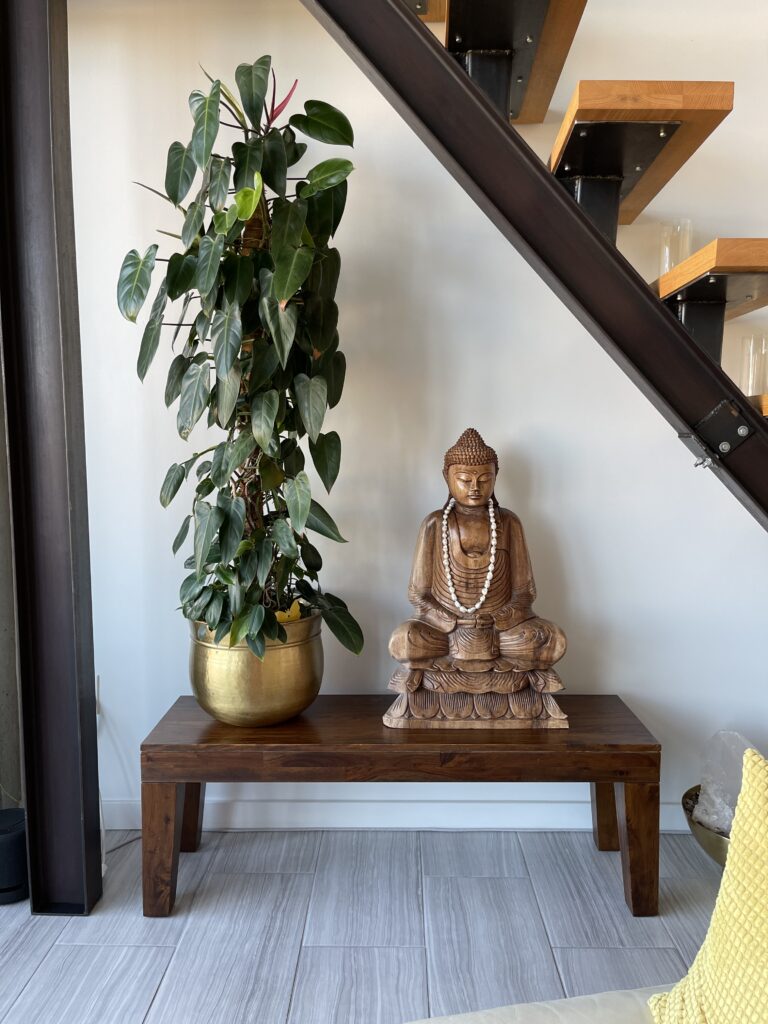Why do we need houseplants?
House plants are a great way to improve the air quality in your home. They also can improve your mood and make your home look nicer. Not only are they beneficial to you, but they are also beneficial to the environment.
Houseplants Remove Toxins
House plants can help remove toxins from the air in your home. Many common house plants, like philodendrons and spider plants, are capable of removing benzene, formaldehyde, and trichloroethylene from the air. These toxins can come from things like furniture, carpeting, and cleaning products. Having a few house plants in your home can help improve the air quality and keep you healthy.
Houseplants Improve Mood
House plants can also improve your mood and sense of well-being. A study published in the Journal of Environmental Psychology found that people who have plants in their homes report feeling happier and more relaxed than those who do not have plants. The presence of plants seems to have a calming effect on people and can help reduce stress levels.
Houseplants are Living Art or Decor
Not only are house plants good for you, but they can also make your home look nicer. House plants add life and color to a room and can help make a space feel more inviting. They can also help offset the effects of negative features in a room, like too much sunlight or not enough ventilation.
Where to begin?
If you are completely new to the world of house plants, then you may be wondering where to start. It can be daunting trying to figure out which plants are easy to care for, and which ones will die on you in less than a week.
That’s why we’ve compiled a list of the 10 easiest house plants for beginners! These plants are low-maintenance, and they’re perfect for people who are just starting out in the world of plant care.
So if you’re looking for an easy way to add some greenery to your home, then read on!
Best Houseplants For Beginners: The Short List
- Heartleaf Philodendron
- Pothos
- Peace Lily
- Cast Iron Plant
- Snake Plant
- Spider Plant
- ZZ Plant
- Dracaena
- Chinese Evergreen
- Rubber Plant
Best Houseplants For Beginners: Bonus Content
- Super Low Lighting: Lucky bamboo
- Full Sun: Aloe Vera and Jade Plant
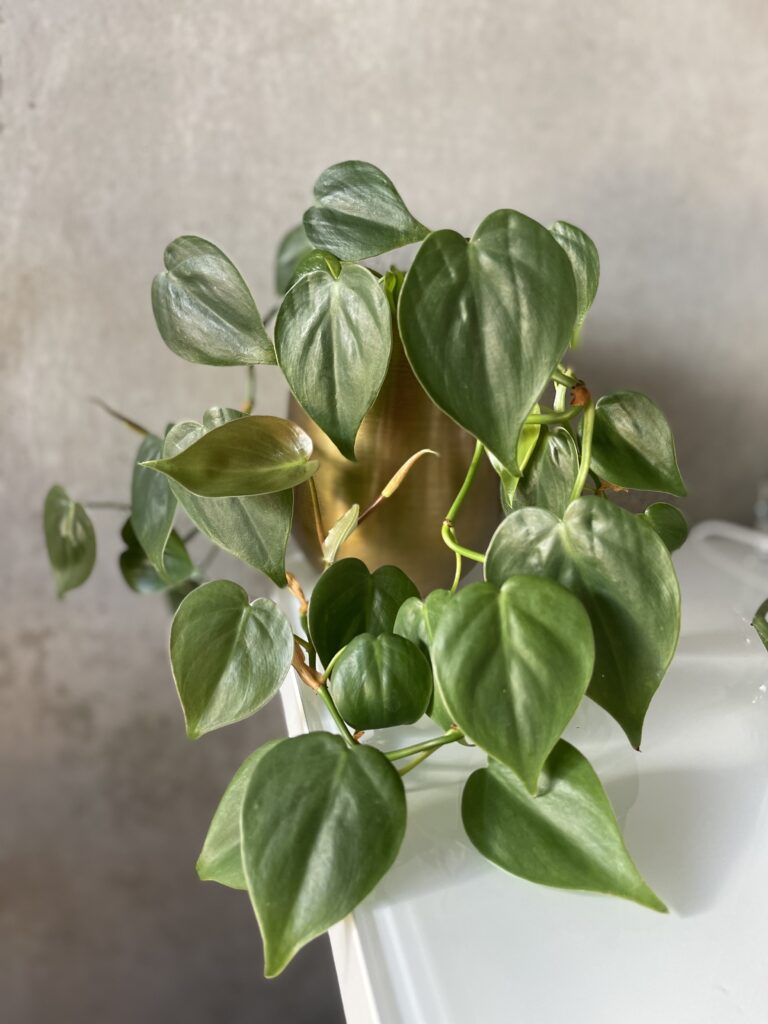

1. Heartleaf Philodendron Vine
If you’re looking for an easy-to-care-for houseplant, the Heartleaf Philodendron is a great option. This plant is low-maintenance and is perfect for people who are just starting out in the world of plant care.
The Heartleaf Philodendron: Philodendron Hederaceum
The Heartleaf Philodendron is a tropical plant originating from South America, Central America, and the Caribbean, where it thrives in humid environments. As such, they perform their best when grown in homes with warm temperate climates and reasonable humidity along with bright indirect light.
Don’t worry if you live in a cooler climate, you can still grow this beautiful plant! Just keep in mind they prefer a reasonable amount of humidity. This means you may need to provide extra humidity in the winter to prevent your heaters from drying out your home’s air and your plants. However, all in all, Heartleaf Philodendrons require very little maintenance, and as mentioned above, they can thrive easily in most homes with bright light.
Caring for the heartleaf Philodendron
These plants are very low maintenance and only require watering when the top inch of the soil feels dry to the touch. They have little maintenance requirements other than needing light or infrequent fertilizing from time to time.
In terms of light requirements, the Heartleaf Philodendron prefers bright indirect light but can also tolerate low levels of sunlight.
Overall, this plant is one of the easiest ones to care for – making it perfect for beginner houseplant gardeners!
2. Pothos Vine
The Pothos plant is by far one of, if not the most popular plants on the planet, and certainly a must-consider on the “best Houseplants For Beginners” list.
The pothos plant is classified as a tropical plant, that usually thrives in humid environments. But fortunately for us, this resilient plant is very adaptable and can tolerate a wide range of growing conditions.
The Pothos Plant: Epipremnum Aureum
Pothos, also known as golden pothos, money plant, or devil’s ivy, is a hardy foliage plant that is native to southeastern Asia. It greatly resembles the common heart-leafed philodendron when young, at first glance they could easily be confused for one another.
The pothos plant is a long living and potentially large vine that features heart-shaped leaves in a variety of variegations that can grow up to twelve inches long in habitat conditions.
Caring for the Pothos Plant
The pothos plant can be grown in either soil or as cuttings grown in water, this makes it a versatile option for new houseplant parents or gardeners. When growing in soil, the pothos plant should be watered regularly and fertilized every two weeks. When grown in water, it’s best to keep the roots submerged below the water line. Also, it is recommended to change out the water completely every two to three weeks to avoid stagnation and the potential of the roots rotting.
The pothos plant can also tolerate low light levels, making it a good choice for homes with limited sunlight. For low light conditions, pothos seems to do better when planted in water versus being planted in soil.
However, pothos ultimately will grow their best if given bright indirect light or bright ambient lighting.
The pothos plant is not only a new houseplant parent right of passage but a great choice for beginner houseplant gardeners.
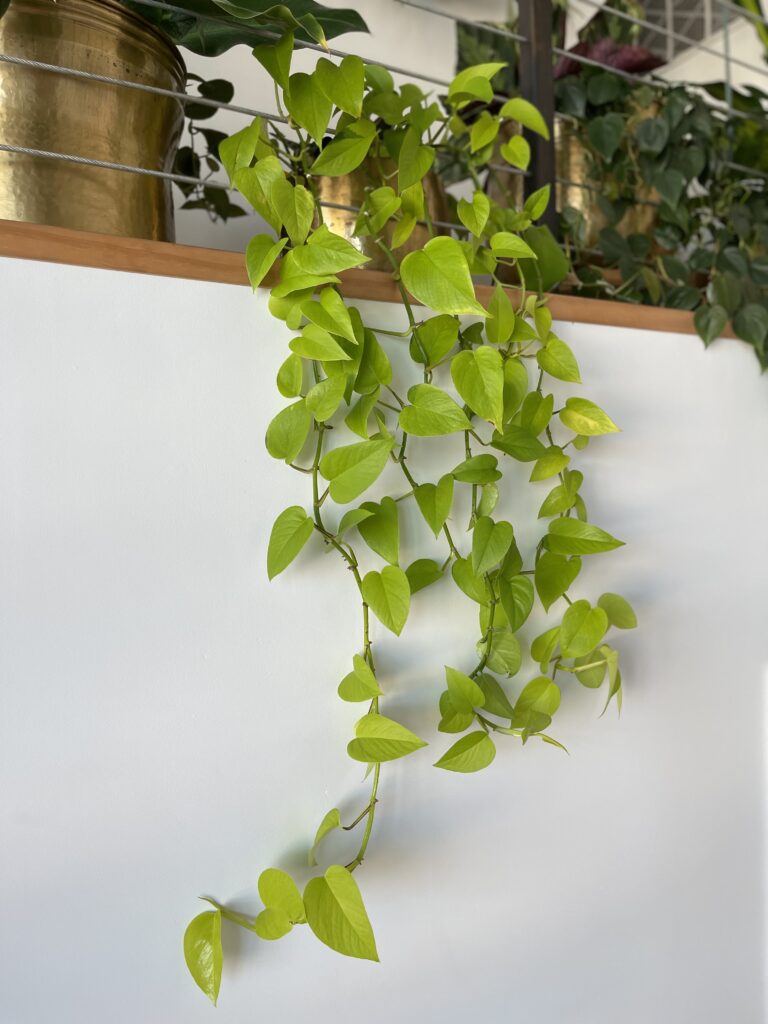

3. Peace Lily
Peace lilies are beautiful, low-maintenance plants that can be a great addition to any home. They are easy to care for and thrive in a variety of conditions, making them a perfect choice for novice gardeners.
The peace lily plant gets its name from the white blooms that resemble delicate lilies. In addition to being attractive, these flowers are also known for their ability to clean the air of toxins. This makes them a popular choice for public spaces or households with pets or smokers.
The Peace Lily Plant: Spathiphyllum
Peace lilies grow best in indirect light or bright light. They can tolerate low light levels, but will not bloom if they do not receive enough bright light. If you don’t have a spot in your home with natural light, you can place your peace lily near a window or use a grow light to provide it with supplemental light.
Caring for the Peace Lily Plant
Water regularly when the top inch of soil is mostly dry and only fertilize monthly with a balanced fertilizer. These are really more of a medium to semi-low-light plant. If your plant is getting too much sun, it may cause the leaves to burn. If this happens you can move it to a shadier spot or use a shade cloth to protect it from the sun’s rays.
In general, peace lilies are very hardy plants and are rarely affected by pests or diseases. However, if your plant begins to look wilted or has yellow leaves, it may be infected with mealybugs or aphids. Spraying the plant with neem oil or a 50/50 solution of rubbing alcohol and water can help get rid of these unwanted pests.
Note:
Overwatering can cause root rot, so make sure to let the soil dry out between waterings.
4. Cast Iron Plant
As if the name did give it away, the cast Iron plant is a tough-as-nails plant that is native to parts of China and Japan. It gets its name for the amazing amount of neglect that this plant can withstand and still look great!
The Cast Iron Plant: Aspidistra elatior
Cast iron plants are popular indoor plants with a reputation for thriving in low-light conditions. This plant has dark green leathery leaves that can grow up to 12 inches long, on top of a long rigged stem. Interestingly, the stems as well as the flowers grow right from the ground. This unique plant grows from a rhizome underground, versus a tree or a vine.
Caring for the Cast Iron Plant
Cast iron plants are relatively easy to care for, and they are tolerant of a wide range of growing conditions. They require little sunlight and can withstand fairly dry soil and a wide range of temperatures. A cast iron plant is also one of the few plants that can filter out benzene from the air. So if you are looking for a low-maintenance indoor plant, the cast iron plant is a great option!
5. Snake Plant
If you are looking for a stylish, yet easy-to-care-for houseplant, the snake plant is a great and versatile option. The snake plant is another very popular houseplant that is known for its easy care and tolerance to a wide range of growing conditions. They require little sunlight and can withstand dry soil and even high temperatures.
The Snake Plant: Sansevieria trifasciata
Is a succulent-like plant that has long, flat, green leaves with white or yellow stripes down the middle. Snake plants can grow up to five feet tall and produce large clusters of small, white flowers. The snake plant definitely makes it to the “best Houseplants For Beginners” list.
Snake plants are one of the few plants that can filter out benzene from the air.
Snake plants are also tolerant of low light levels and can survive in dry soil for weeks at a time. In fact, they thrive in conditions that most other houseplants would not be able to tolerate.
There are many different varieties of snake plants available, they range from small or dwarf ones with leaves that grow in rosettes, to the classic tall varieties.
Caring for the Snake Plant
Snake plants can tolerate low lighting conditions, but will ultimately look their best if provided with ample bright indirect light.
It’s recommended to only water your snake plant when the top inch or two of soil feels dry to the touch. Snake plants prefer to be on the dryer side so be cautious not to water too often, as this can cause root rot. Also fertilize your plant once a month with a balanced fertilizer when watering.
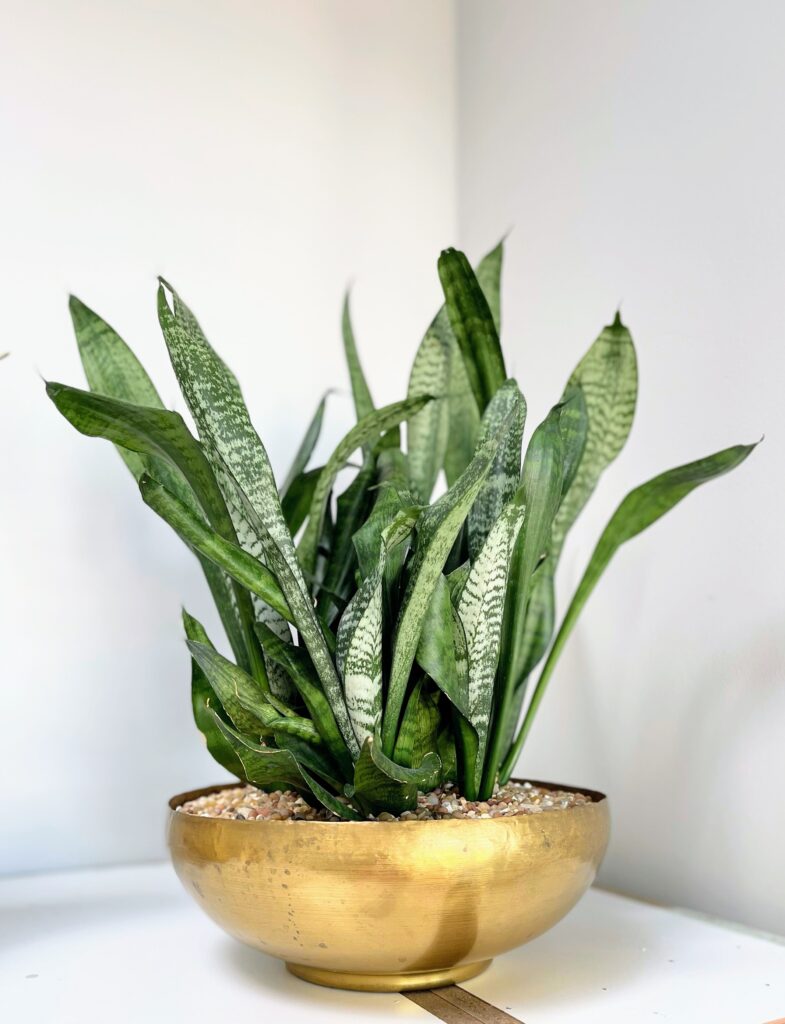

6. Spider Plant
The beautiful Spider Plant is a unique plant in the way that it propagates itself, with mini clones suspended from long stems. These clones or babies will easily root into soil or water if given the chance. This makes this plant great for hanging baskets, a plant stand, or sitting on a ledge.
These are well-loved plant in the easy-to-care-for category. It is a very popular houseplant that is known for its tolerance to a wide range of growing conditions.
The Spider Plant: Chlorophytum Comosum
This plant features grass-like leaves that are bright green with a white stripe down the center.
Spider plants can grow up to 15 inches tall and produce clusters of small, white flowers on long stems. After the plant has finished blooming, the babies will form on the same stems that the flowers did.
This plant is also extremely adaptable and can tolerate periods of drought due to it is thick tuberous water retaining roots.
Caring for Spider Plants
Spider Plants prefer medium to bright indirect light, it is best to avoid direct sun as this may burn the leaves. Due to its root system only water your spider plant when the top inch of soil feels dry to the touch. Do not water too often, as this is unnecessary and can cause root rot. Fertilize your plant once a month with a balanced fertilizer.
If you are looking for an easy-to-care-for houseplant, the spider plant is a good option. They require little sunlight and can withstand dry soil and high temperatures.
7. ZZ Plant
The ZZ plant is an easy-to-grow upright foliage plant with dark green leaves and stems. This plant was commonly used only in commercial spaces but recently has found its way into the houseplant trade. It features deep oval-shaped leaves that start at the top of the thick tapering stem and run down along the sides. The usually arching stem almost has a bulbous base that tapers to a thin point at the top.
The ZZ Plant: Zamioculcas zamiifolia
ZZ plants are a genus of succulent-like plants that are native to eastern Africa. There are about fifteen different species in the genus, ranging from black to new variegated varieties. But the easiest and the most commonly cultivated species is standard green Zamioculcas zamiifolia. ZZ plants have thick rounded potato-like tubers that hold moisture and nutrients, for times of drought. They produce small, white flowers that bloom in clusters.
Caring for ZZ Plants
ZZ plants are definitely on the “best Houseplants For Beginners” list. With a reputation as one of the easiest plants to care for and can tolerate a wide range of growing conditions. They require little sunlight to survive but look best with indirect light.
Water your ZZ plant when the top inch of soil feels dry to the touch. Do not water too often, as this can cause root rot. This plant can survive in dry soil for weeks at a time especially in low light areas. Fertilize your plant once a month with a balanced fertilizer.
If you are looking for an easy-to-care-for houseplant, the ZZ plant is a good option.
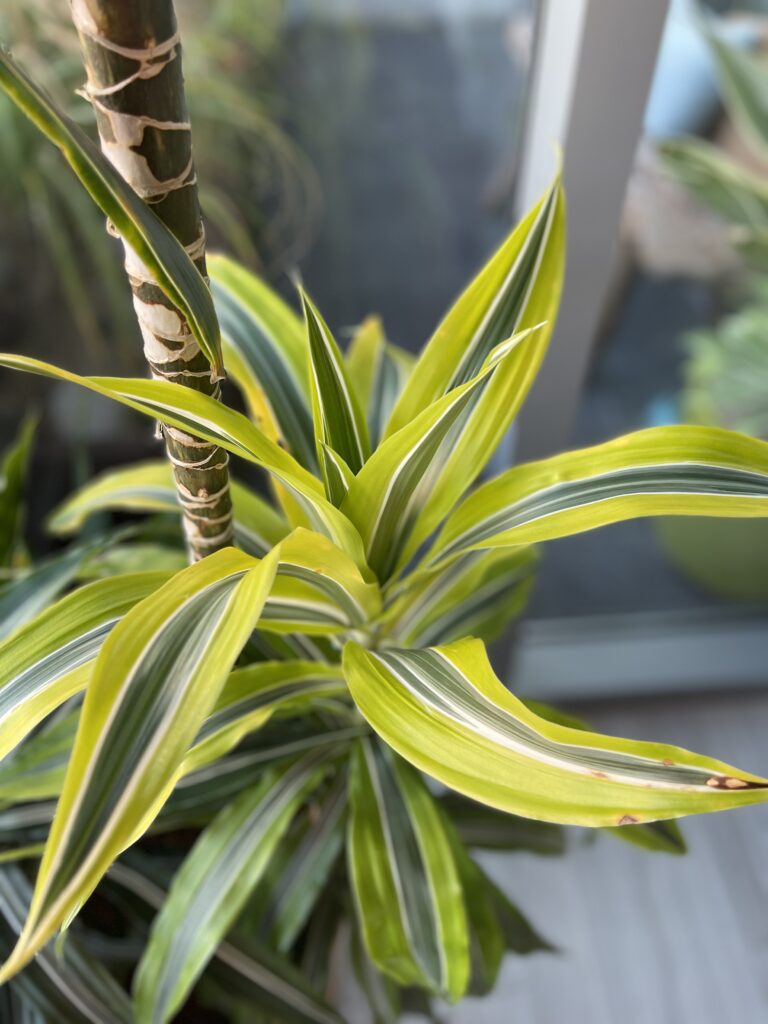

8. Dracaena plant
The Dracaena plant is another popular houseplant for beginners. It is a small indoor tree that is known for its easy care and is very tolerant of a wide range of growing conditions.
Dracaena is the scientific name of this group, which includes about 120 species of the small, medium, and potentially large trees. Dracaena’s claim to fame is for its palm tree-like appearance, it features leaves that range from either multi-colored, thin, and grass-like to medium and wide strap-like leaves. The wide and somewhat long strap-like leaves are commonly found on the varieties referred to as the corn plant. These can range from solid dark green to green with various colors of stripes or variegation.
The Dracaena Plant: Dragon tree, Corn plant
Dracaena plants are also on the clean air list and can filter out chemicals like xylene and formaldehyde from the air. The narrow leaf variety is somewhat tolerant of low light levels but really grows best when given bright light to partial direct sun. The wide leaf variety referred to as the corn plant can tolerate the least amount of light and cannot be placed in direct sun without risking the leaves burning.
Both varieties can survive in dry soil for a somewhat long period of time before needing a good soaking.
Caring for Dracaena Plants
Water your dracaena plant only when the top few inches of the soil feel dry to the touch. If you are growing this plant in a deeply shaded area, in a normal household environment, then it will require very little water.
Water periodically with a deep soaking then let the tree dry nearly completely out before watering again. Do not water too often, as this can cause root rot. Fertilizing your plant once a month with a balanced fertilizer should do the trick.
If you are looking for an easy-to-care-for houseplant, the dracaena plant is a good option.
9. Chinese Evergreen
The Chinese Evergreen is a popular indoor plant that is known for its easy care and also known to tolerate a wide range of growing conditions, including low light conditions. They are native to tropical and subtropical regions of Asia and New Guinea. These large-leaved bushy plants can range in a variety of different colors, and variegation patterns including a variety of bright pink leaves! They are more of a shrub-like plant when fully grown and can reach a height of around 3 feet.
The Chinese Evergreen Plant: Aglaonema
Chinese evergreen plants are also on the clean air list and are known to remove benzene, formaldehyde, carbon monoxide, and trichloroethylene from the air of your space.
Chinese evergreen plants are also tolerant of low light levels, but look their best when given bright indirect light. These tough tropical plants can also survive limited periods of drought or dry soil.
Caring for Chinese Evergreen Plants
It’s best to water your Chinese evergreen plant when the top inch of soil feels mostly dry to the touch. While they can survive periods of drought, they will not look their best if they are frequently water deprived for long periods of time. For an optimal-looking plant fertilize once a month with a balanced houseplant fertilizer.
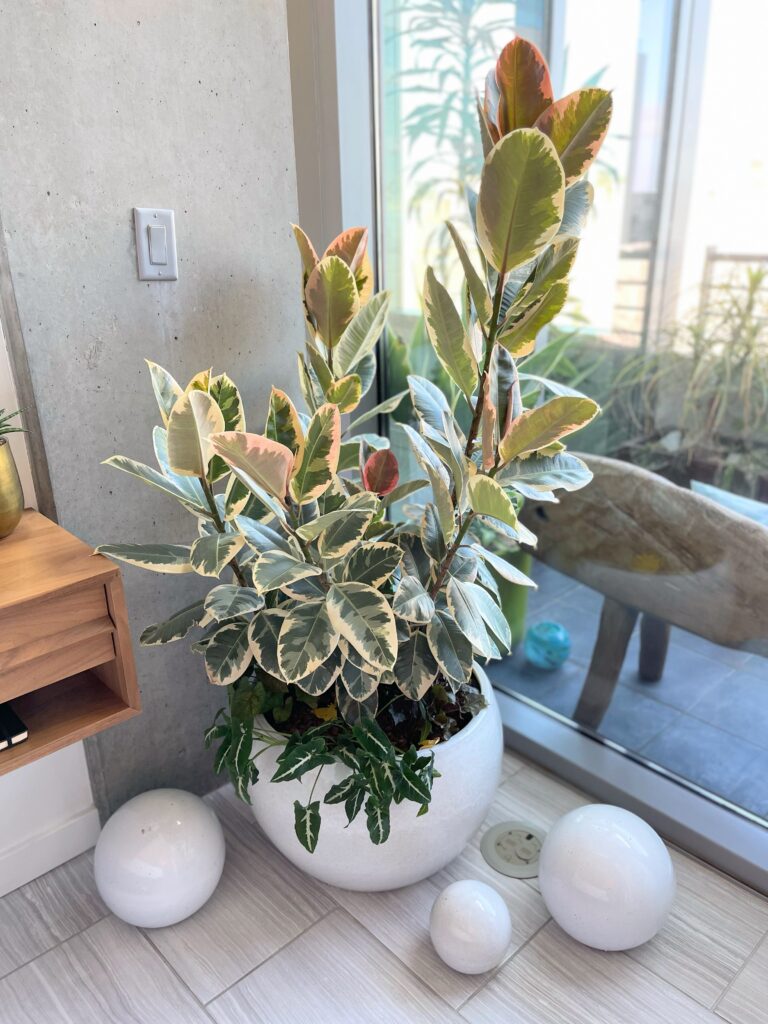

10. The Rubber Plant
The rubber plant also known as rubber fig, rubber bush, and rubber tree is part of the massive fig or ficus family. The rubber plant is native to eastern parts of South and Southeast Asia.
This amazing tree gets its name from the latex found in its sticky white sap. This sap was originally used in the production of rubber.
The rubber tree can grow as big as its environment will allow and features large broad shiny oval-shaped leaves that can reach 14 inches long at maturity. This tree can be grown indoors as well as outdoors and when planted directly in the ground, can reach nearly 100 feet in height. No worries, as a potted plant indoors, it tends to max out around 12 feet or so.
The Rubber Plant: Ficus Elastica
When grown as a houseplant, rubber plants require bright indirect light to partial or indirect sunlight. While they can adapt to direct sunlight, if they are acquired as a houseplant they will burn if placed abruptly in hot direct sunlight.
Like half of the plants on this list, water your rubber plant when the top inch of soil feels dry to the touch. The same goes with the fertilizer, only once a month with a balanced fertilizer is required for this plant.
Best Houseplants For Beginners: Bonus Content
In this Best Houseplants For Beginners bonus content, we will provide a few more options for specific growing conditions in your home or office.
Lucky bamboo
Lucky bamboo, also known as Dracaena sanderiana, is a popular indoor houseplant that is native to Africa. Despite its name, lucky bamboo is not bamboo at all, but a type of dracaena. This easy-to-care-for plant can be found in a variety of shapes and sizes and has long been considered a symbol of good luck and prosperity.
Lucky bamboo is the perfect plant for novice gardeners, as it is incredibly forgiving and low-maintenance. In fact, it can thrive in a wide variety of conditions, from low light to high humidity. Lucky bamboo will thrive in either soil or water, making it the perfect plant for those who have a difficult time remembering to water their plants.
One of the most popular ways to display lucky bamboo is in a vase filled with water. In this arrangement, the stalks of the plant are placed in freshwater, and the roots are allowed to dangle freely in the air. It is important to change the water in this arrangement regularly, as dirty water can quickly kill the plant.
Lucky bamboo can also be grown outdoors in tropical climates. In this environment, it will grow into a large shrub that can reach heights of up to ten feet tall.
Aloe Vera
Aloe Vera is a succulent plant that has been used for centuries for its medicinal properties. Aloe Vera is a cactus-like plant that grows in hot, dry climates. The leaves of the plant are filled with a clear gel that is used to treat burns, skin irritations, and other conditions. Aloe Vera gel is also used to make natural skin care products.
Aloe Vera gel is a natural emollient that helps to soften and moisturize the skin. It is also an anti-inflammatory agent that can help to reduce inflammation and swelling. Aloe Vera gel contains vitamins A, C, and E, as well as minerals like zinc and copper. These nutrients help to nourish the skin and promote healing.
Aloe Vera gel can be used to treat a variety of skin conditions, including sunburns, psoriasis, eczema, and acne. It can also be used to reduce the appearance of scars and wrinkles. Aloe Vera gel is a natural alternative to conventional skin care products.
Jade plant
The Jade Plant is a succulent that is native to South Africa. It is easy to care for and can be kept as a houseplant. The Jade Plant can be propagated from cuttings, and it will grow quickly if given the right conditions.
The Jade Plant has thick, fleshy leaves that are green or variegated with white. It produces small white flowers in the spring or summer. The Jade Plant can be grown outdoors in zones 9-11, or it can be grown indoors as a houseplant.
The Jade Plant is a popular houseplant because it is easy to care for. It does well in bright sunlight or partial shade, and it doesn’t need a lot of water. The soil should be kept dry between waterings, and the plant can be fertilized once a month.
The Jade Plant can be propagated from stem cuttings. Cut off a stem about 6 inches long and remove the leaves from the bottom 2/3 of the stem. Dip the stem in rooting hormone and place it in a pot of moist soil. Keep the soil moist until the cutting roots.
